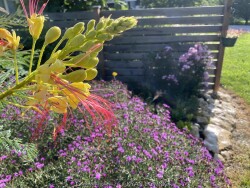

Hardy Bird of Paradise (Caesalpinia gilliesii) is a surprisingly hardy shrub from South America native to Argentina and Uruguay. The extremely fine textured bipennate foliage is fern-like and resembles Mimosa or Amorpha. During spring and summer the lovely foliage takes on a bluish green color. By late summer if conditions are optimal, beautiful flowers appear. The flowers are light yellow with protruding red hair-like stamens that are very showy, drawing in curious visitors. By late fall in our zone 6 climate, the foliage drops and typically the above ground woody part of the shrub freezes back and behaves like a Crapemyrtle or a Butterfly Bush. Trim dead growth in mid-spring and enjoy the new beautiful regrowth by early summer. In order for this shrub to flower, it needs to be well-established, in full sun, and preferably on the south or west side of a foundation. Hardy Bird of Paradise need average to dry well drained soil especially in the winter. Hardiness should not be an issue after seeing mature established plants at the Denver Botanic Garden (zone 5b) in full bloom. The Botanic Garden at Oklahoma State University (zone 7a) also has a few decades old specimens. Wet winter soils could limit its success in zone 5-7 areas in the Eastern United States. It has been thriving in our trial gardens and at several residential gardens in Lawrence, KS (zone 6a) 5-7 years ago. During the arctic blast of February, 2021, lows down to -17 degrees F on Feb 16th, 2021 were recorded. The longevity of this cold blast was also impressive: 10 days on a row with highs of 10-15 degrees F or lower, 8 nights of lows in the single digits and negatives, and 36 straight hours of 0 degrees F and mostly lower. It is virtually unknown in most garden centers but worthy of more wide-scale use especially in hot locations.
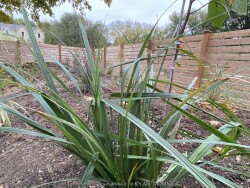

***Description for this grass available with future update!***Korean Feather Reed Grass, is also known as Calamagrostis brachytricha
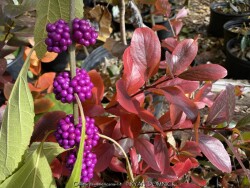

American Beautyberry (Callicarpa americana), native to Southeast US including Oklahoma and Missouri, is one of the most unique and attractive shrubs for berry production. Considered a three-season shrub, green foliage emerges in spring with attractive clusters of tiny pink flowers in summer. Big conglomerates of fruit clusters occur along the stem at evenly spaced intervals. Bright purple in color, the fruit is very effective through the month of October and November in our Zone 6a Kansas climate. Fall foliage is bright yellow often contrasting with the purple berries in November. By the following spring, winter kill to the ground will almost always occur as temperatures regularly drop to 0 degrees F or below. Cut to a few inches off the ground as you would with a perennial. You may choose to do this rejuvenation anyways in Southern areas if it has not been done in a few years to increase fruit production on vigorous new growth. New shoots create fountain-shaped shrub 3-4' after rejuvenation. Flowering occurs on new wood so you will always have berries when using this method. Purple berry clusters are highly ornamental and eaten only very slowly (never stripped clean) by birds. In southern parts of its range, full to part shade is best. However, full to part sun is recommended in zone 6 to maximize energy production needed from the sun in a shorter growing season. Mild drought is tolerated at the expense of dropping fruits if it gets too dry. Our plants in the display garden survived the winter of 2021 with temperatures reaching -16 degrees F coming up reliably from the ground each year. Overall, this is a great "woody perennial" for the Kansas landscape that is unfortunately often underused.
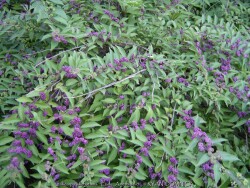

Purple beautyberry (Callicarpa dichotoma 'Early Amethyst'), native to Asia, is one of the most unique and attractive shrubs for berry production. Considered a three-season shrub, green foliage emerges in spring with attractive clusters of tiny pink flowers in summer. Big conglomerates of fruit clusters occur along the stem at evenly spaced intervals. Bright purple in color, the fruit is very effective through the month of October and November in our Zone 6a Kansas climate. Fall foliage is bright yellow often contrasting with the purple berries in November. The following spring, watch for winter kill if temperatures drop below -5 to -10 degrees F and be prepared to cut to a few inches off the ground. You may choose to do this rejuvenation anyways if it has not been done in a few years to increase fruit production on vigorous new growth. New shoots create fountain-shaped shrub 3-4' after rejuvenation. Flowering occurs on new wood so you will always have berries when using this method. Purple berry clusters are highly ornamental but rarely eaten (or stripped clean) by birds. Beautyberry grow best in part to full sun but can also tolerate almost full shade and still produce fruit. This makes them valuable for a north side of the house planting that only gets a couple of months of sun during the high sun angle peak of summer. Mild drought is tolerated at the expense of dropping fruits if it gets too dry. Our plants in the display garden survived without irrigation but did not fruit during the extreme drought of 2011. Overall this is a great plant for the landscape that is unfortunately often underused.
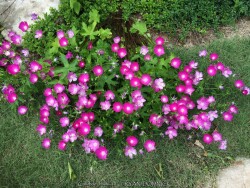

Upright Winecups (Callirhoe bushii) is also called Bush's Poppy Mallow. This plant grows from a carrot like taproot sporting a cluster of semi evergreen foliage around the base. In spring, new upright and prostrate growing vines spread in all directions along the ground up to 3 to 4 feet away from the taproot but do not root along the way. By late May or early June, magenta red "wine cup" shaped flowers cover this plant. The show last for about 4 to 6 weeks or until severe summer drought sets in. Usually in July, the flowering is complete and will set seed if allowed. Foliage will look bedraggled enough to justify complete cut back. This may be a good time to mulch unless you already mulched during the spring. When cooler weather returns in the fall, new growth emerges from the taproot looking attractive again. Secondary flowering may also occur in early fall.especially on summer planted plants. Bush's Poppy Mallow is a rare native wildflower of Missouri, Kansas, Arkansas and Oklahoma in rocky open woods and ravine bottoms. Bush's Poppy Mallow appreciates well drained soil and full to part sun. However we have found that it will still bloom and tolerate almost full shade (just a couple hours) if needed and our 40 inches of rain per year. A great plant for the top of a retaining wall, native pollinator gardens, or to even among other perennials to provide texture and contrast. It's one Achilles' heel is rabbits. Rabbits are usually only a problem in crowded suburbs where they have a little wild vegetation to eat and no predators. Gardeners with lots of established plants usually do not have rabbit problems. If rabbits are a problem for you, and you still want to grow upright wine cups, cover the plant with a bowl shaped piece of chicken wire attached with weed barrier pins. This will allow the taproot and basil foliage to get established the first year without any browsing (flowers may get eaten); after removing the cage the second year, the plants will generally outgrow any rabbit browsing. Other problems could be root rot but I have generally not seen that even in clay soils in Lawrence Kansas. Self seeding should be allowed to gently occur around the base of the plant to ensure a thick groundcover; these plants tolerate crowded conditions and will not crowd each other out or need division. This is one of the most iconic and beautiful native wildflowers!
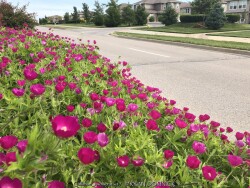

Wine cup (Callirhoe involucrata) is also called purple poppy mallow. This plant grows from a carrot like taproot sporting a cluster of semi evergreen foliage around the base. In spring, new prostrate growing vines spread in all directions along the ground up to 3 to 4 feet away from the taproot but do not root along the way. By late May or early June, magenta red "wine cup" shaped flowers cover this plant. The show last for about 4 to 6 weeks or until severe summer drought sets in. Usually in July, the flowering is complete and will set seed if allowed. Foliage will look bedraggled enough to justify complete cut back. This may be a good time to mulch unless you already mulched during the spring. When cooler weather returns in the fall, new growth emerges from the taproot looking attractive again. Secondary flowering may also occur in early fall.especially on summer planted plants. Poppy mallow winecup is a native plant of the great plains south to Texas and includes most of Kansas. As with most plants native to prairie areas, winecup appreciates well drained soil and full sun. However we have found that it will tolerate almost full shade if needed and our 40 inches of rain per year. A great plant for the top of a retaining wall, native pollinator gardens, or to even among other perennials to provide texture and contrast. It's one Achilles' heel is rabbits. Rabbits are usually only a problem in crowded suburbs where they have a little wild vegetation to eat and no predators. Gardeners with lots of established plants usually do not have rabbit problems. If rabbits are a problem for you, and you still want to grow wine cups, cover the plant with a bowl shaped piece of chicken wire attached with weed barrier pins. This will allow the taproot and basil foliage to get established the first year without any browsing; after removing the cage the second year, the plants will generally outgrow any rabbit browsing. Other problems could be root rot but I have generally not seen that even in clay soils in Lawrence Kansas. Self seeding should be allowed to gently occur around the base of the plant to ensure a thick groundcover; these plants tolerate crowded conditions and will not crowd each other out or need division. This is one of the most iconic and beautiful native wildflowers!


With its glossy burgundy-red foliage, Red Zeppelin sweetshrub (Calycanthus floridus var. purpureus) will rock your world! The color of the foliage lasts all season and is accompanied by lightly fragrant orange-red flowers in late spring and early summer. Not only is it adaptable and easy to grow in the landscape, but our many years of trialing indicate it’s easy to grow in production, too. This selection of our North American native species was developed by the folks at Pleasant Run Nursery. Prune after flowering to maintain shape. Calycanthus perform amazingly well in eastern Kansas landscapes. It is great along a woodland edge or in morning sun, or in full sun for best foliage color show. It tolerates a wide variety of soil types including clay but needs prefers well-drained soil high in organic matter. Adaptable to mild drought and heat but greatly improved with rich, moisture-retentive soils. Typically, our 40 inches of rainfall per year in Eastern Kansas is sufficient. Summer foliage is virtually pest-free. All Proven Winners® plants are legally propagated, healthy and vigorous, true to name, and tagged with color pictures and growing information.
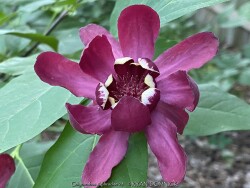

Aphrodite Sweetshrub (Calycanthus x 'Aphrodite') is covered in big, glossy, medium-green leaves. This shrub explodes with enormous cupped flowers that look a bit like a deep red magnolia. They start in early summer with a big flush of flowers continuing to bloom sporadically all summer long. This is a quite large shrub that needs plenty of space to look its best, but if you have the room for it, there are few better ways to use it! 'Aphrodite' is a hybrid between our native Calycanthus and the Asian species, x Sinocalycanthus. You're probably wondering if it's fragrant, and the answer is - it depends. The scent varies based on the age of the bloom, the time of day, and the flower itself. Some people say they smell like pineapple, others apples, others bubblegum, and some get no scent at all. Even if you never sense a whiff off this plant, its fabulous flowers are more than enough reward. Prune after flowering to maintain shape. This Calycanthus performs amazingly well in eastern Kansas landscapes. It is great along a woodland edge or in morning sun. When planted in full shade with rich soil in our Lawrence, KS Zone 6a display garden, growth is very rapid and flowers completely cover the shrub for a few weeks in early summer. Yes, you heard right, this shrub is will flower in full shade. It tolerates a wide variety of soil types including clay but needs prefers well-drained soil high in organic matter. Adaptable to mild drought and heat (plant in full shade in southern zones) but greatly improved with rich, moisture-retentive soils. Typically, our 40 inches of rainfall per year in Eastern Kansas is sufficient. Summer foliage is virtually pest-free. All Proven Winners® plants are legally propagated, healthy and vigorous, true to name, and tagged with color pictures and growing information.
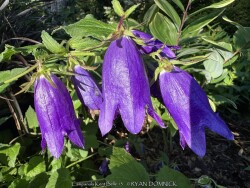

Blue Bellflower (Campanula sp.) is planted for its blue bell shaped flowers and attractive green foliage. Native to different parts of Europe. Generally this plant declines after a few years of Kansas climate but worth a try in perfect soils in well-tended part-shade gardens. Preferring northern climates, lack of moisture, alkaline soils, and competition with weeds seem to be an issue.
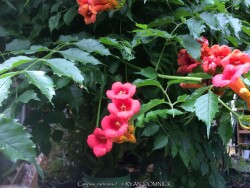

Trumpet vine (Campsis radicans) features shiny dark green foliage, orange-red trumpet-shaped summer flowers, green bean-like seed pods, and gold fall color. Flowers are very attractive to hummingbirds. Trumpet vine is native to the eastern United States including Kansas. Easily grown in a wide variety of soils including heady clay. It is usually grown on pergolas, trellises, and chain-link fences. Beware that this is an extremely vigorous plant that crowds out most weeds and is itself weed-like, with a very spreading growth habit. Best planted and allowed to grow in isolated areas or in horrible soils where no other plant will grow; mowing around it generally stops the yearly spread. Three beautifum mature plants in our display garden grow up posts on the North side of our covered awning behind our shop. They have been thriving for 15 plus years, growing in extremely compacted ab-3 gravel smashed into clay "soil" that is driven on by trucks and constantly walked on. A pick-axe will bounce off with each powerful swing! Now that is a tough "Once it's there, it's there forever" plant!
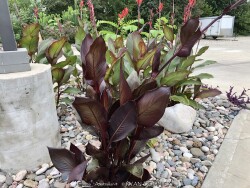

Cannas are typically grown for their continuous summer flowers and vertical wide-leaf foliage. The plants are large tropical and subtropical herbaceous perennials with a rhizomatous rootstock native to areas with a summer monsoon and dry winter. They can be grown as flowering summer patio plants. If growing as a potted plant and trying to overwinter, allowing the foliage to frost is ok, it will not kill the root system. However, do not allow the pot with rootball to freeze solid or go below 20 degrees for more than a few hours; move into a cold garage or basement over the winter with no watering. Cut back and allow to go dormant and place entire pot back out in April or May with a time-release fertilizer. Another more labor intensive way to overwinter cannas is to remove them from the dirt, dust with fungicide, place in box with sawdust, and keep in the refrigerator. We consider this method old-fashioned and too much work but ok if you only want to save a few pieces. If digging from the ground, just save a chunk with the dirt intact and place into a large pot in the garage. During the growing season, fertilize, water regularly, and place in full sun. You may also plant these in the ground for an enormous tropical effect! It is possible to overwinter these in the ground in Kansas by mulching 4-8" thick over deeply planted rhizomes. New growth will usually be slightly delayed but quick to regain full height. In our trial gardens in Lawrence, KS (zone 6a), the following varieties survived after being mulched 6-12" with leaf mulch to -17 degrees F. (Canna 'Daddy's Buckaroo',Canna 'Omega',Canna indica 'Red Stripe',Canna indica 'Ellen's Super Orange', Canna indica 'Wyoming') During the arctic blast of February, 2021, lows down to -17 degrees F on Feb 16th, 2021 were recorded. The longevity of this cold blast was also impressive: 10 days on a row with highs of 10-15 degrees F or lower, 8 nights of lows in the single digits and negatives, and 36 straight hours of 0 degrees F and mostly lower. Canna 'Australia' has maroon leaves and red flowers. This canna can also grow in standing water as a potted plant in water gardens or rain gardens.
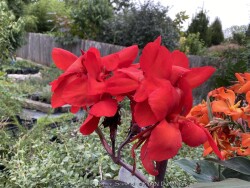

Cannas are typically grown for their continuous summer flowers and vertical wide-leaf foliage. The plants are large tropical and subtropical herbaceous perennials with a rhizomatous rootstock native to areas with a summer monsoon and dry winter. They can be grown as flowering summer patio plants. If growing as a potted plant and trying to overwinter, allowing the foliage to frost is ok, it will not kill the root system. However, do not allow the pot with rootball to freeze solid or go below 20 degrees for more than a few hours; move into a cold garage or basement over the winter with no watering. Cut back and allow to go dormant and place entire pot back out in April or May with a time-release fertilizer. Another more labor intensive way to overwinter cannas is to remove them from the dirt, dust with fungicide, place in box with sawdust, and keep in the refrigerator. We consider this method old-fashioned and too much work but ok if you only want to save a few pieces. If digging from the ground, just save a chunk with the dirt intact and place into a large pot in the garage. During the growing season, fertilize, water regularly, and place in full sun. You may also plant these in the ground for an enormous tropical effect! It is possible to overwinter these in the ground in Kansas by mulching 4-8" thick over deeply planted rhizomes. New growth will usually be slightly delayed but quick to regain full height. In our trial gardens in Lawrence, KS (zone 6a), the following varieties survived after being mulched 6-12" with leaf mulch to -17 degrees F. (Canna 'Daddy's Buckaroo',Canna 'Omega',Canna indica 'Red Stripe',Canna indica 'Ellen's Super Orange', Canna indica 'Wyoming') During the arctic blast of February, 2021, lows down to -17 degrees F on Feb 16th, 2021 were recorded. The longevity of this cold blast was also impressive: 10 days on a row with highs of 10-15 degrees F or lower, 8 nights of lows in the single digits and negatives, and 36 straight hours of 0 degrees F and mostly lower. Canna 'Cannova Bronze Scarlet' is a dwarf variety with reddish leaves and bright red flowers.
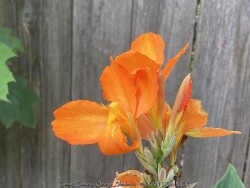

Cannas are typically grown for their continuous summer flowers and vertical wide-leaf foliage. The plants are large tropical and subtropical herbaceous perennials with a rhizomatous rootstock native to areas with a summer monsoon and dry winter. They can be grown as flowering summer patio plants. If growing as a potted plant and trying to overwinter, allowing the foliage to frost is ok, it will not kill the root system. However, do not allow the pot with rootball to freeze solid or go below 20 degrees for more than a few hours; move into a cold garage or basement over the winter with no watering. Cut back and allow to go dormant and place entire pot back out in April or May with a time-release fertilizer. Another more labor intensive way to overwinter cannas is to remove them from the dirt, dust with fungicide, place in box with sawdust, and keep in the refrigerator. We consider this method old-fashioned and too much work but ok if you only want to save a few pieces. If digging from the ground, just save a chunk with the dirt intact and place into a large pot in the garage. During the growing season, fertilize, water regularly, and place in full sun. You may also plant these in the ground for an enormous tropical effect! It is possible to overwinter these in the ground in Kansas by mulching 4-8" thick over deeply planted rhizomes. New growth will usually be slightly delayed but quick to regain full height. In our trial gardens in Lawrence, KS (zone 6a), the following varieties survived after being mulched 6-12" with leaf mulch to -17 degrees F. (Canna 'Daddy's Buckaroo',Canna 'Omega',Canna indica 'Red Stripe',Canna indica 'Ellen's Super Orange', Canna indica 'Wyoming') During the arctic blast of February, 2021, lows down to -17 degrees F on Feb 16th, 2021 were recorded. The longevity of this cold blast was also impressive: 10 days on a row with highs of 10-15 degrees F or lower, 8 nights of lows in the single digits and negatives, and 36 straight hours of 0 degrees F and mostly lower. Canna 'Cannova Orange Shades' is a dwarf variety with green leaves and bright orange flowers.
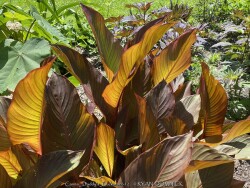

Cannas are typically grown for their continuous summer flowers and vertical wide-leaf foliage. The plants are large tropical and subtropical herbaceous perennials with a rhizomatous rootstock native to areas with a summer monsoon and dry winter. They can be grown as flowering summer patio plants. If growing as a potted plant and trying to overwinter, allowing the foliage to frost is ok, it will not kill the root system. However, do not allow the pot with rootball to freeze solid or go below 20 degrees for more than a few hours; move into a cold garage or basement over the winter with no watering. Cut back and allow to go dormant and place entire pot back out in April or May with a time-release fertilizer. Another more labor intensive way to overwinter cannas is to remove them from the dirt, dust with fungicide, place in box with sawdust, and keep in the refrigerator. We consider this method old-fashioned and too much work but ok if you only want to save a few pieces. If digging from the ground, just save a chunk with the dirt intact and place into a large pot in the garage. During the growing season, fertilize, water regularly, and place in full sun. You may also plant these in the ground for an enormous tropical effect! It is possible to overwinter these in the ground in Kansas by mulching 4-8" thick over deeply planted rhizomes. New growth will usually be slightly delayed but quick to regain full height. In our trial gardens in Lawrence, KS (zone 6a), the following varieties survived after being mulched 6-12" with leaf mulch to -17 degrees F. (Canna 'Daddy's Buckaroo',Canna 'Omega',Canna indica 'Red Stripe',Canna indica 'Ellen's Super Orange', Canna indica 'Wyoming') During the arctic blast of February, 2021, lows down to -17 degrees F on Feb 16th, 2021 were recorded. The longevity of this cold blast was also impressive: 10 days on a row with highs of 10-15 degrees F or lower, 8 nights of lows in the single digits and negatives, and 36 straight hours of 0 degrees F and mostly lower. Canna 'Daddy's Buckaroo' is a tall variety with reddish-green leaves and red-orange flowers. This variety is among the most cold hardy of the cannas due to its vigorous deep growing rhizomes. Our original plant came from Brian's Botanicals mail-order nursery in Kentucky.


***Description for this plant available with future update!*** Canna 'No Dig' is also known as Mixed "No Dig" Winter Hardy Canna.
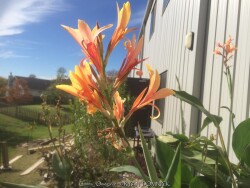

Cannas are typically grown for their continuous summer flowers and vertical wide-leaf foliage. The plants are large tropical and subtropical herbaceous perennials with a rhizomatous rootstock native to areas with a summer monsoon and dry winter. They can be grown as flowering summer patio plants. If growing as a potted plant and trying to overwinter, allowing the foliage to frost is ok, it will not kill the root system. However, do not allow the pot with rootball to freeze solid or go below 20 degrees for more than a few hours; move into a cold garage or basement over the winter with no watering. Cut back and allow to go dormant and place entire pot back out in April or May with a time-release fertilizer. Another more labor intensive way to overwinter cannas is to remove them from the dirt, dust with fungicide, place in box with sawdust, and keep in the refrigerator. We consider this method old-fashioned and too much work but ok if you only want to save a few pieces. If digging from the ground, just save a chunk with the dirt intact and place into a large pot in the garage. During the growing season, fertilize, water regularly, and place in full sun. You may also plant these in the ground for an enormous tropical effect! It is possible to overwinter these in the ground in Kansas by mulching 4-8" thick over deeply planted rhizomes. New growth will usually be slightly delayed but quick to regain full height. In our trial gardens in Lawrence, KS (zone 6a), the following varieties survived after being mulched 6-12" with leaf mulch to -17 degrees F. (Canna 'Daddy's Buckaroo',Canna 'Omega',Canna indica 'Red Stripe',Canna indica 'Ellen's Super Orange', Canna indica 'Wyoming') During the arctic blast of February, 2021, lows down to -17 degrees F on Feb 16th, 2021 were recorded. The longevity of this cold blast was also impressive: 10 days on a row with highs of 10-15 degrees F or lower, 8 nights of lows in the single digits and negatives, and 36 straight hours of 0 degrees F and mostly lower. Canna 'Omega' is a tall variety with blue-green leaves and orange flowers. This variety is the most cold hardy of the cannas due to its vigorous deep growing rhizomes. The rate of spread is faster so provide a larger space for this plant. This canna can also grow in standing water as a potted plant in water gardens or rain gardens.
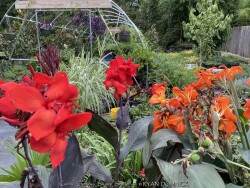

Cannas are typically grown for their continuous summer flowers and vertical wide-leaf foliage. The plants are large tropical and subtropical herbaceous perennials with a rhizomatous rootstock native to areas with a summer monsoon and dry winter. They can be grown as flowering summer patio plants. If growing as a potted plant and trying to overwinter, allowing the foliage to frost is ok, it will not kill the root system. However, do not allow the pot with rootball to freeze solid or go below 20 degrees for more than a few hours; move into a cold garage or basement over the winter with no watering. Cut back and allow to go dormant and place entire pot back out in April or May with a time-release fertilizer. Another more labor intensive way to overwinter cannas is to remove them from the dirt, dust with fungicide, place in box with sawdust, and keep in the refrigerator. We consider this method old-fashioned and too much work but ok if you only want to save a few pieces. If digging from the ground, just save a chunk with the dirt intact and place into a large pot in the garage. During the growing season, fertilize, water regularly, and place in full sun. You may also plant these in the ground for an enormous tropical effect! It is possible to overwinter these in the ground in Kansas by mulching 4-8" thick over deeply planted rhizomes. New growth will usually be slightly delayed but quick to regain full height. In our trial gardens in Lawrence, KS (zone 6a), the following varieties survived after being mulched 6-12" with leaf mulch to -17 degrees F. (Canna 'Daddy's Buckaroo',Canna 'Omega',Canna indica 'Red Stripe',Canna indica 'Ellen's Super Orange', Canna indica 'Wyoming') During the arctic blast of February, 2021, lows down to -17 degrees F on Feb 16th, 2021 were recorded. The longevity of this cold blast was also impressive: 10 days on a row with highs of 10-15 degrees F or lower, 8 nights of lows in the single digits and negatives, and 36 straight hours of 0 degrees F and mostly lower.
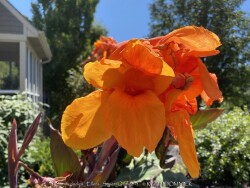

Cannas are typically grown for their continuous summer flowers and vertical wide-leaf foliage. The plants are large tropical and subtropical herbaceous perennials with a rhizomatous rootstock native to areas with a summer monsoon and dry winter. They can be grown as flowering summer patio plants. If growing as a potted plant and trying to overwinter, allowing the foliage to frost is ok, it will not kill the root system. However, do not allow the pot with rootball to freeze solid or go below 20 degrees for more than a few hours; move into a cold garage or basement over the winter with no watering. Cut back and allow to go dormant and place entire pot back out in April or May with a time-release fertilizer. Another more labor intensive way to overwinter cannas is to remove them from the dirt, dust with fungicide, place in box with sawdust, and keep in the refrigerator. We consider this method old-fashioned and too much work but ok if you only want to save a few pieces. If digging from the ground, just save a chunk with the dirt intact and place into a large pot in the garage. During the growing season, fertilize, water regularly, and place in full sun. You may also plant these in the ground for an enormous tropical effect! It is possible to overwinter these in the ground in Kansas by mulching 4-8" thick over deeply planted rhizomes. New growth will usually be slightly delayed but quick to regain full height. In our trial gardens in Lawrence, KS (zone 6a), the following varieties survived after being mulched 6-12" with leaf mulch to -17 degrees F. (Canna 'Daddy's Buckaroo',Canna 'Omega',Canna indica 'Red Stripe',Canna indica 'Ellen's Super Orange', Canna indica 'Wyoming') During the arctic blast of February, 2021, lows down to -17 degrees F on Feb 16th, 2021 were recorded. The longevity of this cold blast was also impressive: 10 days on a row with highs of 10-15 degrees F or lower, 8 nights of lows in the single digits and negatives, and 36 straight hours of 0 degrees F and mostly lower. Canna indica 'Ellen's Super Orange' is a tall variety with reddish-green leaves and bright orange flowers. This variety is among the most cold hardy of the cannas due to its vigorous deep growing rhizomes. Our original plant came from a residential garden in Lawrence, KS.
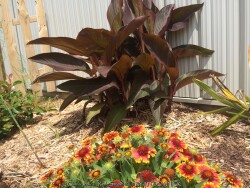

Cannas are typically grown for their continuous summer flowers and vertical wide-leaf foliage. The plants are large tropical and subtropical herbaceous perennials with a rhizomatous rootstock native to areas with a summer monsoon and dry winter. They can be grown as flowering summer patio plants. If growing as a potted plant and trying to overwinter, allowing the foliage to frost is ok, it will not kill the root system. However, do not allow the pot with rootball to freeze solid or go below 20 degrees for more than a few hours; move into a cold garage or basement over the winter with no watering. Cut back and allow to go dormant and place entire pot back out in April or May with a time-release fertilizer. Another more labor intensive way to overwinter cannas is to remove them from the dirt, dust with fungicide, place in box with sawdust, and keep in the refrigerator. We consider this method old-fashioned and too much work but ok if you only want to save a few pieces. If digging from the ground, just save a chunk with the dirt intact and place into a large pot in the garage. During the growing season, fertilize, water regularly, and place in full sun. You may also plant these in the ground for an enormous tropical effect! It is possible to overwinter these in the ground in Kansas by mulching 4-8" thick over deeply planted rhizomes. New growth will usually be slightly delayed but quick to regain full height. In our trial gardens in Lawrence, KS (zone 6a), the following varieties survived after being mulched 6-12" with leaf mulch to -17 degrees F. (Canna 'Daddy's Buckaroo',Canna 'Omega',Canna indica 'Red Stripe',Canna indica 'Ellen's Super Orange', Canna indica 'Wyoming') During the arctic blast of February, 2021, lows down to -17 degrees F on Feb 16th, 2021 were recorded. The longevity of this cold blast was also impressive: 10 days on a row with highs of 10-15 degrees F or lower, 8 nights of lows in the single digits and negatives, and 36 straight hours of 0 degrees F and mostly lower. Canna indica 'Red Stripe' is a medium variety with reddish-green leaves and red flowers.
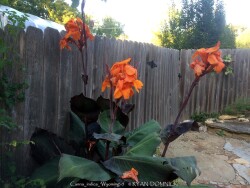

Cannas are typically grown for their continuous summer flowers and vertical wide-leaf foliage. The plants are large tropical and subtropical herbaceous perennials with a rhizomatous rootstock native to areas with a summer monsoon and dry winter. They can be grown as flowering summer patio plants. If growing as a potted plant and trying to overwinter, allowing the foliage to frost is ok, it will not kill the root system. However, do not allow the pot with rootball to freeze solid or go below 20 degrees for more than a few hours; move into a cold garage or basement over the winter with no watering. Cut back and allow to go dormant and place entire pot back out in April or May with a time-release fertilizer. Another more labor intensive way to overwinter cannas is to remove them from the dirt, dust with fungicide, place in box with sawdust, and keep in the refrigerator. We consider this method old-fashioned and too much work but ok if you only want to save a few pieces. If digging from the ground, just save a chunk with the dirt intact and place into a large pot in the garage. During the growing season, fertilize, water regularly, and place in full sun. You may also plant these in the ground for an enormous tropical effect! It is possible to overwinter these in the ground in Kansas by mulching 4-8" thick over deeply planted rhizomes. New growth will usually be slightly delayed but quick to regain full height. In our trial gardens in Lawrence, KS (zone 6a), the following varieties survived after being mulched 6-12" with leaf mulch to -17 degrees F. (Canna 'Daddy's Buckaroo',Canna 'Omega',Canna indica 'Red Stripe',Canna indica 'Ellen's Super Orange', Canna indica 'Wyoming') During the arctic blast of February, 2021, lows down to -17 degrees F on Feb 16th, 2021 were recorded. The longevity of this cold blast was also impressive: 10 days on a row with highs of 10-15 degrees F or lower, 8 nights of lows in the single digits and negatives, and 36 straight hours of 0 degrees F and mostly lower. Canna indica 'Wyoming' is a medium variety with reddish-green leaves and bright orange flowers.
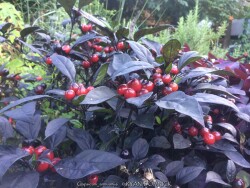

***Description for this plant available with future update!*** Capsicum annuum 'Black Pearl' is also known as Black Pearl Ornamental Pepper (Tropical).
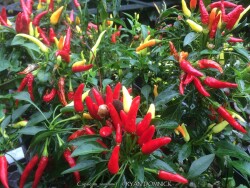

***Description for this plant available with future update!*** Capsicum annuum 'NuMex Easter' is also known as NuMex Easter Ornamental Pepper (Tropical).
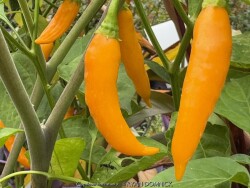

***Description for this plant available with future update!*** Capsicum baccatum 'Aji Amarillo' is also known as Aji Amarillo Peruvian Orange Pepper (Tropical).
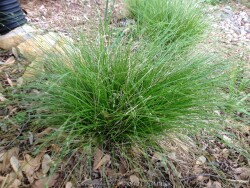

Carex appalachica, commonly called Appalachian Sedge, is native to It is native to the eastern North America, where its typical natural habitat is dry forests and woodlands. It forms a weed-suppressing grass-like clump 12" tall with brown seed heads dangling above. Bright green foliage is extremely fine-textured and hair-like. White-Tinged Sedge is one of the most drought tolerant of the sedges earning a spot in the dry shade garden; it cannot handle extreme drought or extremely rootbound soils though. Root rot can be a problem in poor drainage areas. It prefers average to dry garden conditions with dappled or morning sun. Sun burning is possible with temperatures over 100° so avoid full afternoon sun. Plantings can thrive for many years if in the right spot and there is no such thing as overcrowding. The growth rate is slow at first but eventually forms a nice weed resistant cover so space new plants relatively close together is desiring this effect.
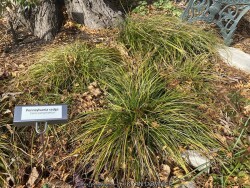

***Description for this grass available with future update!***>>>>>Oak Sedge (Carex pensylvanica) is planted for its attractive grass-like green foliage>>>>>. Foliage maintains well all year provided that certain cultural conditions are met. Carex plantaginea is native to rich deciduous forests in the eastern United States up to Canada. While it excels in moist shaded sites in calcareous soils, it can adapt to difficult dry shaded sites quite well once established. If low temperatures hit 5 degrees F, foliage finally back to the ground and re-emerges in early spring. Generally this plant can decline after a few years of Kansas climate but worth a try in reasonable soils in well-tended shade gardens. Tolerates moderate dry shade with regular weeding: competition with weeds seem to be an issue in low maintenance gardens.
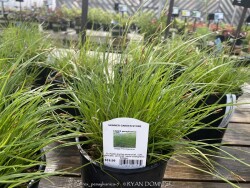

***Description for this grass available with future update!***>>>>>Oak Sedge (Carex pensylvanica) is planted for its attractive grass-like green foliage>>>>>. Foliage maintains well all year provided that certain cultural conditions are met. Carex plantaginea is native to rich deciduous forests in the eastern United States up to Canada. While it excels in moist shaded sites in calcareous soils, it can adapt to difficult dry shaded sites quite well once established. If low temperatures hit 5 degrees F, foliage finally back to the ground and re-emerges in early spring. Generally this plant can decline after a few years of Kansas climate but worth a try in reasonable soils in well-tended shade gardens. Tolerates moderate dry shade with regular weeding: competition with weeds seem to be an issue in low maintenance gardens.


The Saguaro Cactus (Carnegiea gigantea) is probably the most well known iconic cactus out there. Native to the Sonoran Desert in Arizona and Mexico, it's usually grown as a patio or house plant in Kansas. In the wild, established saguaro cacti are hardy to 15 degrees F for short periods of time making them the most cold tolerant columnar tree cactus out there. Growth rates are astonishingly slow: a plant the size od a softball may already be 10-15 years old. A 12" tall specimen may be 20-30 years old. The first arm usually develops around 75 years and plants can live for 200-300 years in hte wild. Grow in full sun with no extra watering except that which comes from rainfall. Repotting may or may not be needed depending on how large you want the plant to grow; plants can continue to grow taller and tolerate extremely root-bound pots but may need wind bracing. If repotting, make sure to use a sharp draining low organic cactus mix with plenty of sand and perlite. Potted plants are hardy to at least 30 degrees F for a short time if kept dry so you are ok if you miss the first light frost. Do not allow the pot with rootball to freeze solid though. Before extreme cold occurs, move to a bright interior window over the winter with no watering and keep above freezing. As a winter house plant, it will look presentable all winter long with just no waterings.(also to prevent soft winter growth) As a permanent house plant, provide bright light and allow the soil to dry between waterings for many years of carefree enjoyment. Plants grown permanently indoors may begin to elongate stretching for light and lose their spine color. It can be hard to reproduce the intense UV sunlight they need so moving outside for the summer is best. Generally if moving outside for the summer, allow 1-2 weeks of part shade or morning sun before placing in full sun. Plants with time to acclimate will thrive in full sun but be careful not to rush it or sunburning will occur. Potted plants are very low maintenance. I have never seen any insect problems on this plant.
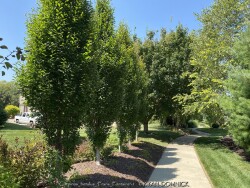

***Tree descriptions available with future update!*** Carpinus betulus 'Frans Fontaine' is also known as Frans Fontaine Columnar European Hornbeam
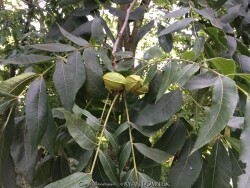

***Tree descriptions available with future update!*** Carya illinoinensis is also known as Hardy Pecan
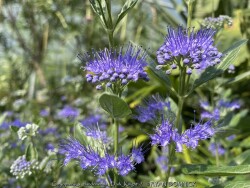

Dark Knight Caryopteris (Caryopteris x clandonensis 'Dark Knight') features darker green summer foliage followed by late-summer deep blue flowers and a compact growing habit. It adds much-needed color to the late summer landscape and makes a handsome companion with perennials. A great favorite with pollinators of all types (bees, butterflies, and hummingbirds) in the late season garden. Caryopteris demands a sunny spot and very well-drained soil. Wet soils, particularly those that remain soggy during periods of cold weather, will cause root rot. For this reason, we recommend early season planting of caryopteris in zones 5. In Eastern Kansas, this cultivar performs WELL with just about everything nature has to challenge it! Heat and drought are tolerated well. Cold tolerance is no problem for us in zone 6. Caryopteris gives great winter interest with it's dried flowers. The only maintenance this shrub needs is cutting back about 1/2 way in early spring before new growth emerges. No disease or pest problems. Great plant for berms or hot West or South exposures in full sun. Do not plant in rich moist soils or root rot will probably occur. Even when not blooming, the compact green foliage looks good on it's own or combines well with earlier season blooming red, purple, blue, or magenta flowering plants. Combine with crapemyrtles and butterflybush to create a late season "all you can eat" buffet for pollinators!
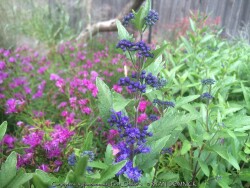

First Choice Caryopteris (Caryopteris x clandonensis 'First Choice') blooms earlier than other earlier caryopteris. This shrub develops a compact, tight habit with dark green foliage and deep blue long-lasting flowers. In Eastern Kansas, this cultivar performs WELL with just about everything nature has to challenge it! Heat and drought are tolerated well. Cold tolerance is no problem for us in zone 6. Caryopteris gives great winter interest with it's dried flowers. The only maintenance this shrub needs is cutting back about 1/2 way in early spring before new growth emerges. No disease or pest problems. Great plant for berms or hot West or South exposures in full sun. Do not plant in rich moist soils or root rot will probably occur. Even when not blooming, the compact green foliage looks good on it's own or combines well with earlier season blooming red, purple, blue, or magenta flowering plants. Combine with crape myrtles and butterfly bush to create a late season "all you can eat" buffet for pollinators!


Lil Miss Sunshine® Bluebeard (Caryopteris x clandonensis 'Lil Miss Sunshine') shows off vivid color from spring through frost! Among the most colorful of all garden plants, spring foliage emerges bright gold lasting all summer. In late summer, blue flowers begin to appear and persist through mid-autumn with unforgettable contrast. It's late season bloom time brings interest to the landscape when not much else is blooming and the nectar-rich flowers provide food for pollinating insects and hummingbirds. Compact size works well in perennial gardens or landscape beds. Excellent as part of the mixed border or in the perennial bed, it adds a shot of bold color to the late summer garden. Fertilize with a controlled release fertilizer in spring. In Eastern Kansas, this cultivar performs WELL with just about everything nature has to challenge it! Heat and drought are tolerated well. Cold tolerance is no problem for us in zone 6. Caryopteris gives great winter interest with it's dried flowers. Tip dieback is common after cold winters. The only maintenance this shrub needs is cutting back about 1/2 way in early spring before new growth emerges. In Northern areas it may die completely to the ground. The plant blooms on the current season's growth so will flower even if cut to the ground in spring. Great plant for berms or hot West or South exposures in full sun. No disease or pest problems except root rot; do not plant in rich moist soils or root rot will probably occur. Even when not blooming, the intense gold foliage looks good on it's own or combines well with earlier season blooming red, purple, blue, or magenta flowering plants. Combine with crapemyrtles and butterflybush to create a late season "all you can eat" buffet for pollinators! All Proven Winners® plants are legally propagated, healthy and vigorous, true to name, and tagged with color pictures and growing information.


Sunshine Blue® II Bluebeard (Caryopteris x clandonensis 'Sunshine Blue II') is the hardiest caryopteris yet! Sunshine Blue II is a new, improved variety of the classic Sunshine Blue, but it's much more tolerant of cold climates. If you've had trouble with bluebeard surviving winter in your area in the past, now's your chance to enjoy the vivid gold foliage and blue blooms of this late blooming favorite. An excellent plant for attracting pollinators! Top reasons to grow Sunshine Blue II caryopteris: 1.The hardiest caryopteris yet - survives winter even in the Midwest. 2.Colorful all season, especially late in summer when blue flowers appear. 3.Thrives in hot, dry, sunny spots. Maintenance Notes: Plant bluebeard in full sun and well-drained soil. Though Sunshine Blue II tolerates colder conditions than other caryopteris, it will do best if you avoid planting it in spots where the soil is cold or wet in winter and early spring. Cut back hard in spring, after the new growth emerges. Avoid late season planting in coldest parts of its hardiness range. In Eastern Kansas, this cultivar performs WELL with just about everything nature has to challenge it! Heat and drought are tolerated well. Cold tolerance is no problem for us in zone 6. Caryopteris gives great winter interest with it's dried flowers. The only maintenance this shrub needs is cutting back about 1/2 way in early spring before new growth emerges. No disease or pest problems. Great plant for berms or hot West or South exposures in full sun. Do not plant in rich moist soils or root rot will probably occur. Even when not blooming, the intense gold foliage looks good on it's own or combines well with earlier season blooming red, purple, blue, or magenta flowering plants. Combine with crapemyrtles and butterflybush to create a late season "all you can eat" buffet for pollinators! All Proven Winners® plants are legally propagated, healthy and vigorous, true to name, and tagged with color pictures and growing information.
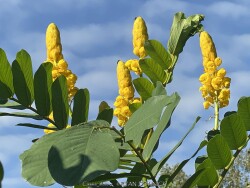

Yellow Candlestick Tree (Cassia / Senna alata) is grown in Kansas as a giant annual capable of reaching 6 to 12 feet in one season. Growth is slow at first in Spring when temperatures are still cool. It is native to tropical rainforests in Mexico and South America generally fulfilling the role of a pioneer species rapidly colonizing disturbed areas. Bright green bi-pinnate leaves are symmetrically arranged and very tropical looking. As branching and growth form develop, the overall geometrical effect is stunning even without flowers yet. Finally by September and all through October until frost, yellow candle-like flowers tower over the foliage. Some plants may have up to 50-100 flower spikes at one time. Cut down promptly after frost as there is no winter interest. Seeds rarely have time to develop in our shorter growing season but it is possible to harvest seeds if the first fall freeze is late. Yellow Candlestick Tree grows fastest in rich well drained soils and plenty of water. Growth is equally impressive in most Kansas soils including heavy clay as long as watering is sufficient. Yellow Candlestick Tree needs hot summers, full sun, and warm humid conditions to thrive. When grown in a large pot, it is very difficult to overwinter inside so it's best to buy new plants each year. This plant has also evolved and interesting relationship with ants, providing nectary glands (food) in exchange for protection from insect pests. Use Yellow Candlestick Tree where you need to fill up a lot of space in a hurry or just like lots of yellow flowers in the fall when other things are not blooming. Interestingly, the foliage is sensitive to light, folding up neatly at sunset and opening up the nest morning.
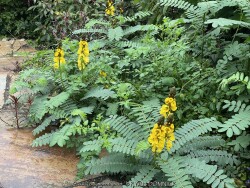

***Description for this plant available with future update!*** Cassia didymobotrya is also known as Popcorn Plant (Tropical).
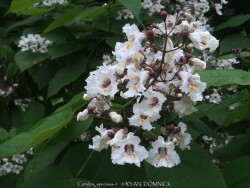

***Tree descriptions available with future update!*** Catalpa speciosa is also known as Northern Catalpa
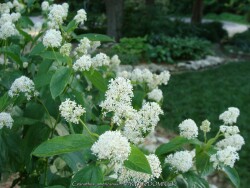

***Shrub descriptions available with future update!*** Ceanothus americanus is also known as New Jersey Tea.
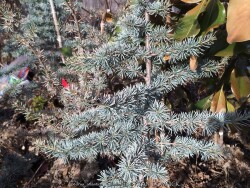

Blue Atlas Cedar (Cedrus atlantica 'Glauca') is an outstanding ornamental conifer tree with the characteristic conical shape and bluish-silver color. Foliage density is very compact along the branches but with plenty of space between branches, enough to show off the wonderful architectural branching structure of the tree. It is cold and drought tolerant enough to survive in much of Kansas with mature specimens (15-30' tall) occasionally seen in Lawrence and Kansas City. In Eastern Kansas, typically our 40 inches of rainfall is sufficient without extra water if planted in good soils. Avoid poorly drained clay soils especially that hold water for more than a day. Numerous cultivar selections are available, many for improved blue color of the needles or different growth forms. There is at least one "weeping" selection that I have witnessed prospering in Lawrence, KS for many years surviving -16 degrees F and a week of single digit highs in February, 2021.
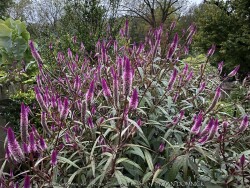

Flamingo Feather Celosia (Celosia argentea var. spicata 'Flamingo Feather') is a large magenta flowering annual. Growth starts off in May when temperatures have warmed. Beautiful dark green foliage has reddish colored back sides of the leaf and magenta stems. After achieving about 3 to 4 feet in height and wide, fuzzy magenta flower spikes begin to appear usually by July. Ultimate height can reach 5-6 feet as flowering becomes more dense and continues until frost providing an excellent long-lasting show. Celosia has little winter interests so you may cut down promptly after the first fall freeze. This is a time to save some of the seeds if you wish to sprinkle them in a new area next year. You may or may not enjoy the fact that the Celosia will easily re-seed itself in areas that you do not mulch. Seedlings come up rather late and can create a carpet under the previous years planting location. We usually allow self-seeding to occur in our display garden in select areas and then spray Roundup or mulch wherever you do not want seedlings. Flamingo Feather Celosia needs full sun for best flowering but tolerated virtually any soil conditions including compacted driveway gravel. Use Flamingo Feather Celosia where you need to fill up a lot of space in a hurry or just like lots of magenta flowers in the fall when other things are not blooming. Celosia is also grown as a food crop in Africa and Southeast Asia.
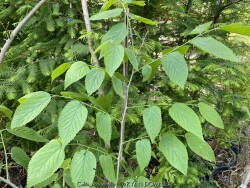

***Tree descriptions available with future update!***Hackberry, is also known as Celtis occidentalis
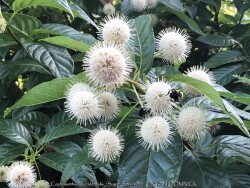

Button bush (Cephalanthus occidentalis) is a beautiful rounded shrub with glossy green leaves that turn reddish maroon in fall. White flowers are very unique (and look like a coronavirus) consisting of small spheres with protruding anthers. Bloom occurs all summer and are attractive to many different bee and butterfly species, including the swallowtail butterfly. Red fruiting heads appear in late summer adding to the ornamental appeal! In its native habitat covering most of Eastern United States including disjunct populations in Arizona, California, and Mexico, this wetland shrub can be found in low-lying areas. This includes swamps, marshes, bogs, wetlands, and along the edges of ponds, streams, and rivers. In Eastern Kansas, this is a no-brainer shrub to small tree for average garden soils including heavy clay and useful for rain gardens. Adapts to a wide range of soils except dry ones if in poor soils. Tolerant of moderate drought once established especially if in moisture-retentive rich soils. As a testament to this plants survivability, Clinton Lake and Perry Lake located in NE kansas flooded in 2020 with areas of shore-line underwater for the entire growing season. This killed every other plant species was killed except for buttonbush: all top growth was killed but new shoots from the root systems of thousands of plants along the shore resumed the following year when water receded. Basically, these plants survived over 18 months with no growth from fall of 2019 to spring of 2021. This plant can also grow in permanent standing water or as a potted plant in water gardens. Sugar Shack® Buttonbush (Cephalanthus occidentalis 'Sugar Shack') in a new Proven Winners variety! Although buttonbush has long been prized as a native and great for rain gardens, it was way too big for most landscapes. Not anymore! They cut the size in half and added improved colorful red fruit and glossy foliage. Add in cool looking, fragrant white flowers and you've got a delightful plant that shines from spring to fall. Blooming on new wood, button bush may be trimmed in early spring. Complete rejuvenation may also be done if plants get too big.
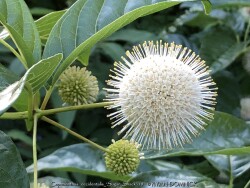

Button bush (Cephalanthus occidentalis) is a beautiful rounded shrub with glossy green leaves that turn reddish maroon in fall. White flowers are very unique (and look like a coronavirus) consisting of small spheres with protruding anthers. Bloom occurs all summer and are attractive to many different bee and butterfly species, including the swallowtail butterfly. Red fruiting heads appear in late summer adding to the ornamental appeal! In its native habitat covering most of Eastern United States including disjunct populations in Arizona, California, and Mexico, this wetland shrub can be found in low-lying areas. This includes swamps, marshes, bogs, wetlands, and along the edges of ponds, streams, and rivers. In Eastern Kansas, this is a no-brainer shrub to small tree for average garden soils including heavy clay and useful for rain gardens. Adapts to a wide range of soils except dry ones if in poor soils. Tolerant of moderate drought once established especially if in moisture-retentive rich soils. As a testament to this plants survivability, Clinton Lake and Perry Lake located in NE kansas flooded in 2020 with areas of shore-line underwater for the entire growing season. This killed every other plant species was killed except for buttonbush: all top growth was killed but new shoots from the root systems of thousands of plants along the shore resumed the following year when water receded. Basically, these plants survived over 18 months with no growth from fall of 2019 to spring of 2021. This plant can also grow in permanent standing water or as a potted plant in water gardens. Sugar Shack® Buttonbush (Cephalanthus occidentalis 'Sugar Shack') in a new Proven Winners variety! Although buttonbush has long been prized as a native and great for rain gardens, it was way too big for most landscapes. Not anymore! They cut the size in half and added improved colorful red fruit and glossy foliage. Add in cool looking, fragrant white flowers and you've got a delightful plant that shines from spring to fall. Blooming on new wood, button bush may be trimmed in early spring. Complete rejuvenation may also be done if plants get too big.
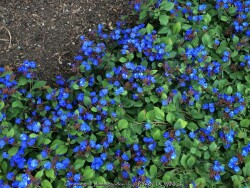

Creeping Plumbago / Leadwort (Ceratostigma plumbaginoides) is a Chinese native plant well adapted to our climate without being invasive in Kansas. It features nonstop royal blue flowers from midsummer till hard freeze; Usually three months or more. After a first light freeze, if flowering is still occurring, rich green foliage will turn bright red while still containing a few blue flowers. This creates a one-of-a-kind contrast not seen in any other plants. Plumbago combines well with just about any other plant due to its rare flower color. This is especially dramatic is combining it with opposites on the color wheel like orange, red or yellow. Growth is often slow to emerge in the spring as plumbago needs warmer soil than most other plants to start growing. This allows for a good combination for spring bulbs to grow with plumbago coming up later to hide the dying bulb foliage. In Kansas landscapes, plumbago is often used as a full sun groundcover in hot areas such as west or south side of the house. Normal garden conditions and berms are fine as well. Plants can survive and flower in shade but growth will be much slower and risk of death will be present until established. In zone 6a, all plantings should be mulched and only larger size established pots should be planted if in the fall. Plumbago sold in flats of many smaller plants can safely be planted in spring or summer. Plumbago needs medium to dry soil tolerating clay as long as everything as well-drained. Once plants are established for a season or two in full sun, they are nearly indestructible. Slow spread will occur and plants will develop very high density smothering out weeds. Sometimes the slowly spreading growth (underground rhizones) can be a problem after a decade or so. However, if you plan ahead and use it as a groundcover like intended, it will be perfect. Being a very low maintenance plant not requiring extra watering or deadheading, the only thing you need to do is weed-eat or cut back all the foliage in the winter. Plumbago has no pest or disease problems.
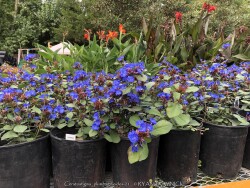

Creeping Plumbago / Leadwort (Ceratostigma plumbaginoides) is a Chinese native plant well adapted to our climate without being invasive in Kansas. It features nonstop royal blue flowers from midsummer till hard freeze; Usually three months or more. After a first light freeze, if flowering is still occurring, rich green foliage will turn bright red while still containing a few blue flowers. This creates a one-of-a-kind contrast not seen in any other plants. Plumbago combines well with just about any other plant due to its rare flower color. This is especially dramatic is combining it with opposites on the color wheel like orange, red or yellow. Growth is often slow to emerge in the spring as plumbago needs warmer soil than most other plants to start growing. This allows for a good combination for spring bulbs to grow with plumbago coming up later to hide the dying bulb foliage. In Kansas landscapes, plumbago is often used as a full sun groundcover in hot areas such as west or south side of the house. Normal garden conditions and berms are fine as well. Plants can survive and flower in shade but growth will be much slower and risk of death will be present until established. In zone 6a, all plantings should be mulched and only larger size established pots should be planted if in the fall. Plumbago sold in flats of many smaller plants can safely be planted in spring or summer. Plumbago needs medium to dry soil tolerating clay as long as everything as well-drained. Once plants are established for a season or two in full sun, they are nearly indestructible. Slow spread will occur and plants will develop very high density smothering out weeds. Sometimes the slowly spreading growth (underground rhizones) can be a problem after a decade or so. However, if you plan ahead and use it as a groundcover like intended, it will be perfect. Being a very low maintenance plant not requiring extra watering or deadheading, the only thing you need to do is weed-eat or cut back all the foliage in the winter. Plumbago has no pest or disease problems.
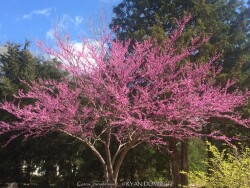

***Tree descriptions available with future update!***Eastern Redbud, is also known as Cercis canadensis
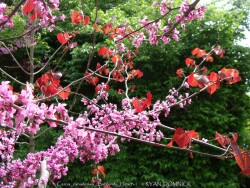

Cercis canadensis Burgundy Hearts® is an improved reddish purple-leaf variety developed by Greenleaf Nurseries in Oklahoma. Burgundy Hearts more drought and heat tolerant. Pinkish-lavender April flowers bloom for about a month before leaves appear. It has a more or less rounded form, wider than it is tall. This small deciduous tree is known for its heart-shaped leaves that hold their dark color longer in the summer, taking on reddish wine tones towards the fall. Many of the problems with the regular species redbud tree are not an issue with this improved cultivar. It is to be expected however that all Redbuds have a relatively short lifespan of 20-40 years but even so, are worth planting for its beautiful flowers. It is not weak wooded and makes a nice hot non-sparking firewood. The short life span is not due to breakage so much as it is to the tree's susceptibility to heart-rot especially when branch crotches form and get older. Other problems include canker, verticillium wilt and root rot. Most redbud varieties thrive in full sun to partial shade. They will tolerate full shade but become elongated and thin as they reach for the sun. Redbuds do well in most soil types but adequate drainage is a must; it can tolerate dry shade of Eastern Kansas forests receiving at least 35" of rainfall per year. The species is a native from southern Canada to Florida, east to Kansas. The regular species also has the potential to self seed in your yard but not Burgundy Hearts. As a dwarf tree, use 'Merlot' as a specimen or part of a group. It reaches about 20 to 30 feet high and wide in full sun. Reddish leaf color emerges in the spring and is maintained all summer long if in mostly full sun. The color of older purple redbuds (like Forest Pansy) fades to dark green as the summer heat intensifies.
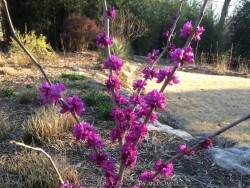

Don Egolf Redbud (Cercis canadensis 'Don Egolf') is a dwarf flowering shrub redbud native to China. It has the typical heart shaped green Redbud foliage and deep magenta flowers. The bark is more of a beige or light tan color with black buds. Flowering begins in April with flower buds starting on old wood all the way to the ground level. Flowering even occurs on very young plants only several inches tall. Because this is a Chinese species, no seed pods form like on native Redbuds. After many years, heights of 8 to 10 feet may be achieved on multi-stemmed plants. Culture conditions are pretty easy; just provide average garden soil, reasonable water, and mostly sun. In Eastern Kansas, typically our 40 inches of rainfall is sufficient without extra water if planted in good soils. Don Eagles Red has been growing in our display garden for over 10 years blooming consistently with no problems. It survived -16 degrees F and a week of single digit highs in February, 2021 with no damage to flower buds.
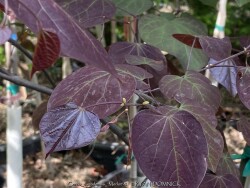

This purple-leaf Redbud (Cercis canadensis 'Merlot') is a canadensis and texensis cross to produce a more drought and heat tolerant tree. It has glossy, small rounded dark purple leaves and has an upright vase-shaped growth habit. This small deciduous tree is known for its stunning display of colorful blooms a deep magenta color. Many of the problems with the regular species redbud tree are not an issue with this improved cultivar. It is to be expected however that all Redbuds have a relatively short lifespan of 20-40 years but even so, are worth planting for its beautiful flowers. It is not weak wooded and makes a nice hot non-sparking firewood. The short life span is not due to breakage so much as it is to the tree's susceptibility to heart-rot especially when branch crotches form and get older. Other problems include canker, verticillium wilt and root rot. Most redbud varieties thrive in full sun to partial shade. They will tolerate full shade but become elongated and thin as they reach for the sun. Redbuds do well in most soil types but adequate drainage is a must; it can tolerate dry shade of Eastern Kansas forests receiving at least 35" of rainfall per year. The species is a native from southern Canada to Florida, east to Kansas. The regular species also has the potential to self seed in your yard but not 'Merlot'. As a dwarf tree, use 'Merlot' as a specimen or part of a group. It reaches about 12 to 15 feet high and wide in full sun. Reddish leaf color emerges in the spring and is maintained all summer long if in mostly full sun. The color of older purple redbuds (like Forest Pansy) fades to dark green as the summer heat intensifies.
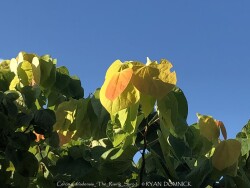

***Tree descriptions available with future update!*** Cercis canadensis 'The Rising Sun' is also known as Rising Sun Gold-Leaf Redbud
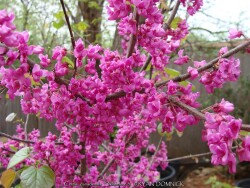

***Tree descriptions available with future update!*** Cercis canadensis ssp texensis 'Oklahoma' is also known as Oklahoma Redbud